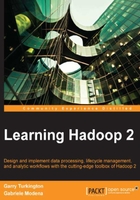
Running the examples
The source code of all examples is available at https://github.com/learninghadoop2/book-examples.
Gradle (http://www.gradle.org/) scripts and configurations are provided to compile most of the Java code. The gradlew script included with the example will bootstrap Gradle and use it to fetch dependencies and compile code.
JAR files can be created by invoking the jar task via a gradlew script, as follows:
./gradlew jar
Jobs are usually executed by submitting a JAR file using the hadoop jar command, as follows:
$ hadoop jar example.jar <MainClass> [-libjars $LIBJARS] arg1 arg2 … argN
The optional -libjars parameter specifies runtime third-party dependencies to ship to remote nodes.
The copyJar Gradle task can be used to download third-party dependencies into build/libjars/<example>/lib, as follows:
./gradlew copyJar
For convenience, we provide a fatJar Gradle task that bundles the example classes and their dependencies into a single JAR file. Although this approach is discouraged in favor of using –libjar, it might come in handy when dealing with dependency issues.
The following command will generate build/libs/<example>-all.jar:
$ ./gradlew fatJar